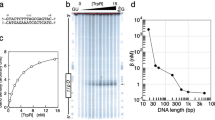Abstract
The Escherichia coli nucleotide exchange factor GrpE accelerates the rate of ADP dissociation from high affinity ADP–DnaK, thus enabling ATP binding and transition to the low affinity state. We show here that GrpE, in the absence of ATP, accelerates the rates of the forward and reverse reaction ADP–DnaK–P ⇌ ADP–DnaK + P, where P denotes peptide substrate. Specifically, the binding of GrpE to an ADP–DnaK–P (or DnaK–P) complex increases koff and kon by ∼200-fold and ∼60-fold, respectively. The results are consistent with a GrpE- induced conformational change in the C-terminal polypeptide binding domain of an ADP–DnaK molecule, which results in a unique low affinity intermediate from which peptide can dissociate. A simulation of peptide dissociation from DnaK as a function of the [ATP] / [ADP] ratio shows that GrpE induced peptide dissociation from ADP–DnaK is important at elevated cellular concentrations of ADP, which typically occur upon stress.
This is a preview of subscription content, access via your institution
Access options
Subscribe to this journal
Receive 12 print issues and online access
$189.00 per year
only $15.75 per issue
Buy this article
- Purchase on Springer Link
- Instant access to full article PDF
Prices may be subject to local taxes which are calculated during checkout





Similar content being viewed by others
References
Georgopoulos, C. & Welch, W.J. Annu. Rev. Cell Biol. 9, 601–634 (1993).
Hendrick, J.P. & Hartl, F.-U. Annu. Rev. Biochem. 62, 349–384 (1993).
Becker, G. & Craig, E.A. Eur. J. Biochem. 219, 11–23 (1994).
Bucherberger, A. & Bukau, B. In Guidebook to molecular chaperones and protein-folding catalysts. (ed., Gething, M.-J.) 22–25 (Oxford University Press, Oxford; 1997).
Zylicz, M., Ang, D. & Georgopoulos, C. J. Biol. Chem. 262, 17437–17442 (1987).
Liberek, K., Skowyra, D., Zylicz, M., Johnson, C. & Georgopoulos, C. J. Biol. Chem. 266, 14491–14496 (1991).
Jordan, R. & McMacken, R. J. Biol. Chem. 270, 4563–4569 (1995).
Schönfeld, H.-J., Schmidt, D., Schröder, H. & Bukau, B. J. Biol. Chem. 270, 2183–2189 (1995).
Packschies, L. et al. Biochemistry 36, 3417–3422 (1997).
Palleros, D.R., Reid, K.L., Shi, L., Welch, W.J. & Fink, A.L. Nature 365, 664–666 (1993).
Pierpaoli, E.V., Sandmeier, E., Schönfeld, H.-J. & Christen, P. J. Biol. Chem. 273, 6643–6649 (1998).
Szabo, A. et al. Proc. Natl. Acad. Sci. USA 91, 10345–10349 (1994).
Hartl, F.U. Nature 381, 571–580 (1996).
Harrison, C.J., Hayer-Hartl, M., Di Liberto, M., Hartl, F.-U. & Kuriyan, J. Science 276, 431–435 (1997).
Farr, C.D., Galiano, F.J. & Witt, S.N. Biochemistry 34, 15574–15582 (1995).
Gragerov, A., Zeng, L., Zhao, X., Burkholder, W. & Gottesman, M.E. J. Mol. Biol. 235, 848–854 (1994).
Zhu, X. et al. Science 272, 1606–1614 (1996).
Pierpaoli, E.V., Gisler, S.M. & Christen, P. Biochemistry 37, 16741–16748 (1998).
Schmid, D., Baici, A., Gehring, H. & Christen, P. Science 263, 971–973 (1994).
Takeda, S. & McKay, D.B. Biochemistry 35, 4636–4644 (1996).
Wu, B., Wawrzynow, Zylicz, M. & Georgopoulos, C. EMBO J. 15, 4806–4816 (1996).
Slepenkov, S.V. & Witt, S.N. Biochemistry 37, 16749–16756 (1998).
Mayer, M. et al. Nature Struct. Biol. 7, 586–593 (2000).
Barshop, B.A., Wrenn, R.F. & Frieden, C. Anal. Biochem. 130, 134–145 (1983).
Gisler, S.M., Pierpaoli, E.V. & Christen, P. J. Mol. Biol. 279, 833–840 (1998).
Russell, R., Jordan, R. & McMacken, R. Biochemistry 37, 596–607 (1998).
Slepenkov, S.V. & Witt, S.N. Biochemistry 37, 1015–1024 (1998).
Neuhard, J. & Nygaard, P. In Eschericha coli and Salmonella typhimurium. Vol. 1 (ed., Neidhardt, F.C.) 447 (American Society for Microbiology, Washington, DC; 1987).
Jensen, P.R., Loman, L., Petra, B., van der Weijden, C. & Westerhoff, H.V. J. Bacteriol. 177, 3420–3426 (1995).
Schirmer, E.C., Queitsch, C., Kowal, A.S., Parsell, D.A. & Lindquist, S. J. Biol. Chem. 273, 15546–15552 (1998).
Acknowledgements
This work was supported by a NIH grant to S.N.W. We thank D. Dwyer, M. Sehorn and S. Slepenkov for a critical reading of the manuscript and helpful discussions.
Author information
Authors and Affiliations
Corresponding author
Rights and permissions
About this article
Cite this article
Mally, A., Witt, S. GrpE accelerates peptide binding and release from the high affinity state of DnaK. Nat Struct Mol Biol 8, 254–257 (2001). https://doi.org/10.1038/85002
Received:
Accepted:
Issue Date:
DOI: https://doi.org/10.1038/85002
This article is cited by
-
Multifactorial level of extremostability of proteins: can they be exploited for protein engineering?
Extremophiles (2017)
-
The kinetic parameters and energy cost of the Hsp70 chaperone as a polypeptide unfoldase
Nature Chemical Biology (2010)
-
Site-Saturation Mutagenesis of Leucine 134 of Bacillus licheniformis Nucleotide Exchange Factor GrpE Reveals the Importance of this Residue to the Co-chaperone Activity
The Protein Journal (2010)



